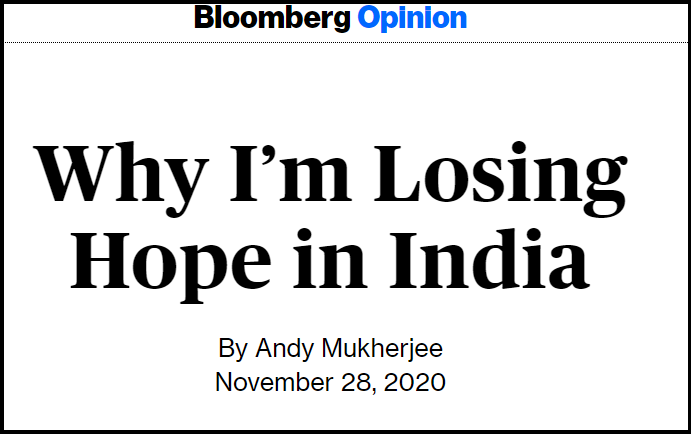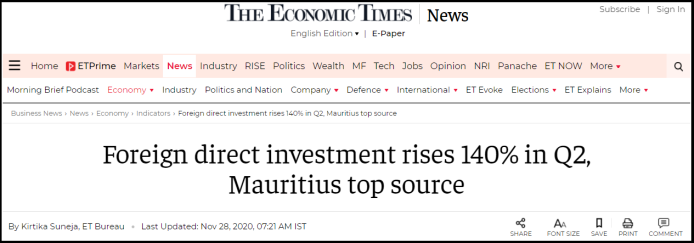Everything is wrong with the Indian economy. The New York Times certainly thinks so. See this article complete with the picture of manual labourers working the ground with the most primitive tools in India. In the foreground, a sad-looking man carries what appears to be construction material on his head.

Look more carefully. I’m sure the New York Times has managed to squeeze in the image of a snake charmer somewhere, along with that of an overcrowded train with passengers hanging from the sides and sitting on the roof.
There has been a flood of articles in such years, with outlets such as The Economist, Bloomberg, Washington Post and others falling over each other to describe India’s doom. Look here, some guy called Andy Mukherjee is losing hope in India. And Bloomberg thinks he is important enough that we all need to know about his mood swings.

Too late to the party, Andy. Collectively, The Economist, The Washington Post, TIME Magazine and all their peers have produced a glut of such articles already. You might as well have written about how you are just hearing about the so called Y2K crisis.
These articles have been music to the ears of the opposition parties in India. A salve on their wounds, now that they appear to be almost completely out of the business of winning elections. If they can’t wean people away from Modi, they can at least snarl at him like so many racoons. Look, the world has lost all hope in India. Who will invest in India anyway, amid all the “rising hate”?
The concerns are not altogether misplaced. Unfavorable headlines in global news outlets can be a hurdle for attracting investment. And bad headlines abroad are an embarrassment for Indians at home. A bit of inferiority complex. Along with good old “log kya kahenge?”
The thing is; it’s not working. The data doesn’t stack up. This is not a lament about how our economy is doing great and how big global media is being mean to us. I’m turning the spotlight around. I am challenging this big global media. Has your negative coverage managed to impact investment in India? Don’t give me ‘mahaul.’ Give me data. What do the numbers say?

How did that happen? You told us that India’s economy was over. Especially after those horrific Q1 numbers. But how did real investors perceive the same numbers? They saw it as an opportunity to invest. A 140% surge in FDI, on a year on year basis, surely cannot be taken lightly. If you put Q1 and Q2 together, the FDI is still up by a rosy 15% on Y-o-Y basis (Apr-Sep, 2020). When the lockdown happened, you in the global media told us that India’s fate was sealed forever. However, investors seem to have taken a different view. They saw it as a pause, after which India would come roaring back. In other words, it seems investors believed the government’s version and not the global media version.
So what happened? Did investors not read your newspapers? Did they not listen to the mood swings of your columnists? You folks have been crying about India’s economy for over two years now. Are investors not reading this. Or have they stopped taking you seriously?
In case you don’t know, FDI in India was up 16% in 2019. For comparison, FDI growth in the US and China for 2019 was 0% each. The EU experienced a 15% contraction and the UK a 6% contraction. Let me repeat. This was 2019. So two back to back years of global media saying that it’s all over for the Indian economy. Two back to back years of investors giving these outlets the royal snub.
For a while now, the global media and its expert columnists have excelled in telling unpleasant truths to India. Let me point the finger the other way and tell them an unpleasant truth. Investors have stopped taking you seriously. Yes indeed.
Right now, India’s BSE Sensex has zoomed passed the 45,000 mark. Foreign portfolio investments are at historic levels. Okay, we have all heard the excuse that stock markets can be disconnected from the real economy. Still, it is mysterious that people would take such a big risk and invest in what is the world’s worst economy according to you.
Okay, so why did Brazil and Russia, two of India’s BRIC peers, see their currencies collapse by 33% and 25% respectively since the beginning of this year? The Indian Rupee only depreciated by 3-4% during the same period. So there is faith in our markets and in our currency. Apparently, both are disconnected from economic reality.
Okay, so what else is disconnected from economic reality? Not just foreign portfolio investments, but actual FDI coming in for the long haul? They are disconnected too?
So who is connected to the economic reality? Just your columnists? Or are there some numbers to back up the ‘mahaul‘ that the world is no longer investing in India? Face it, global media. Foreign investors don’t take you seriously.
I will tell you how it happened. Look at this headline from mid 2019 when the Indian stock market was undergoing a crash.

Look who likes to connect the stock markets to the real economy and Modi’s leadership – when the market is crashing, that is. The market zoomed again by the end of that year 2019. Then came the Coronavirus. The markets have recovered again and zoomed to historic levels. Did you see global media put out screaming headlines, this time in praise of “Narendra Modi’s India”?
Of course not. And that’s how you folks lost credibility with investors. If you think foreign investors have not noticed the bias, you and your columnists are even more clueless than I imagined.
The same goes with Coronavirus. Here is how it was reported when the going was bad.

But soon after, India stabilized. And then steadily brought things under control. At the same time, case numbers and fatalities began soaring in Europe. But India’s recovery was not rewarded with favorable headlines. Nor were European countries taunted for their failures the way India was.
Perhaps the NYT thinks nobody noticed the bias. Unfortunately for them, that’s impossible. Investors need to keep track of every dollar and every penny. Just because the NYT decided to go silent when India’s case numbers declined does not mean global investors stopped keeping track of events. They noticed. And they also noticed the convenient silence of the New York Times.
The next time the New York Times reports on India, they will be taken even less seriously. Anti-India bias has cost global media its credibility.
Let us zoom out and look at the big picture here. In 2011, at the beginning of the decade, India’s economy was smallest among all BRIC countries. Both Brazil and Russia were ahead of us. And of course, China. In 2020, India’s GDP is *twice* the size of Brazil and 77% larger than Russia. Despite all the bad publicity.
What are the chances that global investors have not noticed? I would say zero.
And what are the chances that those same investors haven’t noticed the deliberate silence of global media on these cold hard facts, just because they favor India? Again, zero.
I suspect that we have reached an inflexion point regarding reporting on the Indian economy. News about anti-India bias in global media has spread. More of the same anti-India bias won’t cost India. It will cost global media their credibility. They can either mend their ways or continue on their downward spiral. Their choice.
Face it, global media. And suck on it.



